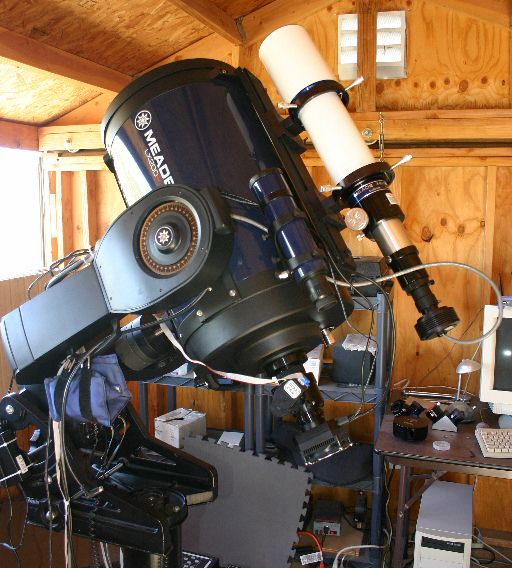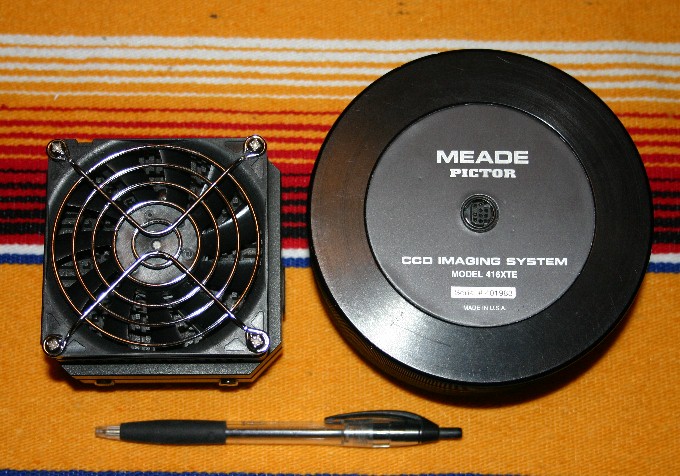Meade 12" LX200R
At the heart of the MSO is the Meade 12" (305mm) LX200R telescope. It is mounted on a Meade super-wedge, which in turn is mounted on a 6" steel pier. Meade has since renamed this telescope to be the LX200ACF.
It has superb optics with Meade’s Ultra High Transmission Coatings (UHTC) which allows up to 19% more light transmission than traditional Schmidt-Cassegrain telescopes.
Meade 80mm APO Refractor
This 80mm refractor is mounted pigg-back on the LX200R and is serves two purposes: 1) a guide telescope when imaging with the LX200R and 2) wide-field imaging. For imaging, an APO is the way to go as the have excellent color correction and yield sharp images.
Williams Optics 80mm Megrez
This is the original Megrez and was billed as a "semi-APO" when it was first introduced. This was used originally as a guide telescope, but because it isn't an APO, it suffered from chromatic abberations. Images taken with it have blue halos around the brighter stars. The Meade 80mm was purchased to solve the chromatic aberration problem.

QHY8
This is a one shot color camera with a very large sensor. This is used mainly for color imaging.
Meade 416XTE
This is an older monochrome camera with a very small sensor chip. It still works well and is used for astrometric measurements.
SBIG ST-4
Attached to the 80mm is a SBIG ST-4 camera of mid-90’s vintage. The ST-4 is a guide camera and is used in conjunction with software for auto-guiding the 12” when performing the imaging. Autoguiding the 12” is essential as it has significant enough error in its tracking to blur star images.

CCD cameras require software to control them and to process the resulting images. Several software packages are used to acquire and process astro-images:
Maxim/DL
This is the software used to:
- control telescope positioning
- control the CCD cameras by taking and downloading the images
- control the ST-4 autoguider camera to autoguide the 12”
- perform the photometric analysis on the final images from both cameras
CCDSoft PEMPro
This software was used to dramatically reduce the tracking error of the 12” which ultimately enabled the possibility of taking longer exposures with minimal tracking errors.
Deep Sky Stacker
DSS is free software and is the primary software used to process and combine the various types of CCD images required to produce the highest quality image possible.
Focus-Max
This free software has sophisticated algorithms for quickly focusing motorized focusers. It works especially well with the RoboFocus hardware. It has an ASCOM interface (ASCOMWeb) that allows one to write Visual Basic scripts that perform custom focusing operations.
Cartes du Ciel
This free software displays star charts of any part of the sky. It can be loaded with any number of star catalogues to provide accurate photometric values for a given star. I loaded it with the USNO-A catalogue (USNOWeb) of stars and used it to identify reference stars in the field being imaged. These reference stars with known magnitudes were used when performing the photometric analysis in Maxim/DL.
Crayford Focuser & Robofocus
A NGF-S focuser replaces the stock crayford focuser that came with the LX200R. This contains a Robofocus electric focuser that is computer controlled to achieve perfect focus.
Focal Reducer
A Meade f6/3 focal reducer is used to lower the focal length of the LX200R. This is important when performing CCD imaging as it allows a larger celestial object to fit on the camera sensor.
The picture below shows the focal reducer attached to the back of the LX200R. The focuser with the Robofocus stepper motor is attached to the focal reducer and the QHY8 camera is attached to the focuser.

